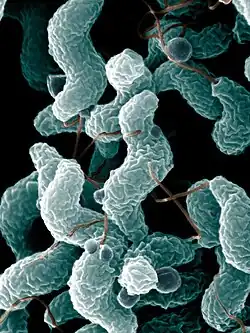| Fletchervirus | |
|---|---|
 | |
| Myoviridae bacteriophage | |
| Virus classification | |
| (unranked): | Virus |
| Realm: | Duplodnaviria |
| Kingdom: | Heunggongvirae |
| Phylum: | Uroviricota |
| Class: | Caudoviricetes |
| Order: | Caudovirales |
| Family: | Myoviridae |
| Subfamily: | Eucampyvirinae |
| Genus: | Fletchervirus |
Fletchervirus is a genus of virus of the subfamily Eucampyvirinae and the phylum Uroviricota (Bacteriophage). This genus contains 5 different species. The family Myoviridae that this genus is a part of is identified from other bacteriophage species by its choice of host, bacteria of the genus Campylobacter.[1] Fletchervirus like most bacteriophage are harmless to humans and thus have no antiviral drugs associated with them. They can be found worldwide and just like most bacteriophage species are found in almost all ecological environments including humans.[2]
Comparative morphology
Fletchervirus differs from its sibling (Firehammervirus) genus morphologically. Members of the genus have heads with a larger diameter and tails that are far shorter. For example, the species Campylobacter virus CP81 in the Fletchervirus genus has a head with 96 nm diameter, and a 97 nm long tail, whereas Campylobacter virus CP220 in the Firehammervirus genus has a head with a 93 nm diameter and a 140 nm long tail.[2][3]
Genetically, members of Fletchervirus have a smaller genome that codes for less proteins, they dsDNA is also permuted circularly. Whereas, members of Firehammervirus have a larger genome with more proteins and a liner permuted dsDNA complex. For example, Campylobacter virus CP81 has a genome of 132 kb that codes for 149 proteins versus Campylobacter virus CP220 that has a genome 197 kb that codes for 257 proteins.[2][3]
Host and phage therapy
Campylobacter is a genus of Gram-negative bacteria. It is found mostly in raw meats, and if consumed can be a terrible pathogen for humans often causing diarrhea, cramps, fever and pain. Bacteriophage therapy is a growing research field, particularly in many species of Campylobacter. Members of the Fletchervirus have been specifically and promisingly tested for medical use to fight strands of antibiotic resistant Campylobacter.[4][5][6]

Taxonomy
Parent subfamily:
Eucampyvirinae
Child species:
- Campylobacter virus CP81
- Campylobacter virus CP30A
- Campylobacter virus CPX
- Campylobacter virus Los1
- Campylobacter virus NCTC12673
Sibling genus:
Firehammervirus
Nibling species:
- Campylobacter virus CP21
- Campylobacter virus CP220
- Campylobacter virus CPt10
- Campylobacter virus IBB35
References
- ↑ Javed, Muhammad Afzal; Ackermann, Hans-Wolfgang; Azeredo, Joana; Carvalho, Carla M.; Connerton, Ian; Evoy, Stephane; Hammerl, Jens André; Hertwig, Stefan; Lavigne, Rob; Singh, Amit; Szymanski, Christine M. (2014-01-01). "A suggested classification for two groups of Campylobacter myoviruses". Archives of Virology. 159 (1): 181–190. doi:10.1007/s00705-013-1788-2. hdl:1822/27453. ISSN 1432-8798. PMID 23881082. S2CID 254050425.
- 1 2 3 "Fletchervirus ~ ViralZone". viralzone.expasy.org. Retrieved 2022-06-29.
- 1 2 "Firehammervirus ~ ViralZone". viralzone.expasy.org. Retrieved 2022-06-29.
- ↑ Connerton, P.L.; Timms, A.R.; Connerton, I.F. (August 2011). "Campylobacter bacteriophages and bacteriophage therapy: Campylobacter bacteriophages". Journal of Applied Microbiology. 111 (2): 255–265. doi:10.1111/j.1365-2672.2011.05012.x. PMID 21447013. S2CID 46270047.
- ↑ "CDC Online Newsroom - Press Release - Infections from some foodborne germs increased, while others remained unchanged in 2012". www.cdc.gov. Retrieved 2022-06-29.
- ↑ Humphrey, Tom; O'Brien, Sarah; Madsen, Mogens (2007-07-15). "Campylobacters as zoonotic pathogens: A food production perspective". International Journal of Food Microbiology. 117 (3): 237–257. doi:10.1016/j.ijfoodmicro.2007.01.006. ISSN 0168-1605. PMID 17368847.
